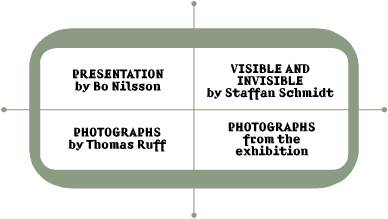
One of the most noteworthy phenomena in contemporary art during the eighties was the emergence of art photography. Some dismissed it as a short-lived fad, but to the younger generation of artists who had cut their teeth on photographic images in newspapers, magazines and television, the photograph was a medium as natural as painting or installations.
A generation of artists has sprung up in Sweden whose artistic medium is photography. Their point of departure is the important center of photography which originated in Bernd Becher's class at the Academy of Art in Düsseldorf and which has turned out photographers such as Candida Höfer, Thomas Struth, Thomas Ruff, Andreas Gursky, Petra Wunderlich and Axel Hütte, all of whom have become part of the face of contemporary photography. Paradoxically, Andreas Gursky is the only one ever to be shown in Sweden, even though the influence of Thomas Ruff has demonstrably been more important.
To most, the name of Thomas Ruff is for ever associated with his gigantic portraits and architectural photos which has become an integral part of the pictorial heritage of the eighties. The purpose of this, his first, mid-career retrospective is to broaden our notion of Thomas Ruff's artistry to include genres such as interiors, portraits, architecture, newspaper photos, stars, night scenes, architectural pictures of the works of Herzog & de Meuron, other portrais and 3D pictures. Consequently, the exhibition will cover all genres of importance from 1979 up to the present. The idea behind this retrospective is not just to demonstrate the width of his artistry but also its conceptual complexity.
From an iconographic point of view, Thomas Ruff's imagery does not appear particularly noteworthy. His portraits do not depict people who are famous in any way. They convey a general impression of a lack of identity, where the abscence of personality has become part of the contemporary human context. Nor were the motifs of his early architectural photos picked for their architectonic qualities. The subjects of his images are neither extravagant nor stereotypical, but quite ordinary in an everyday sort of way.
What is interesting about Ruff's photographs is their serial character, their oversized dimension and the extreme precision with which they are presented, something which often endows the picture with an overload of information.As a result, the image is fragmented into details which occasionally turn into abstractions despite their figurative origin. The objectivity which characterizes his photographs is an effort to avoid anything that smacks of ambivalence. They resist any interpretation - it is the viewer and his subjectivity which are projected against the empty photographic space. Thias quality is the reason why Thomas Ruff's earlier photography has been described as formalistic.
Nor does the internal relationship between the elements in the series attract our attention - if anything, they display an incoherence and lack of logic that is rooted in his deep distrust of photography as a simple attitude vis-à-vis reality.
This is especially noticible in his series of pictures of stars which seems to emanate from no one person, but are observations in black and white, documenting constellations of stars. Precisely because they emanate from no one, Ruff refuses to allow the infinite expanse of nature with its symbolist baggage of science and religion to be carried over into the sublime - instead, it reverts to being documentary photos.
In the same way, his Night series, with their characteristic phosphorescent green light, shows Ruff working with a camera that is able to penetrate the dark. We move through the lens of the view-finder through the dark streets of Düsseldorf on a strictly documentary mission, but the abscence of any human life lends the images an air of mystery, like in a Grade B movie. Is the photographic image so overburdened by its own rhetoric that we can no longer retain a sense of objectivity towards it, or is this metaphysics nothing but a figment of our own imagination that has no analogue in the pictures of Thomas Ruff?
Bo Nilsson
Director





![]()